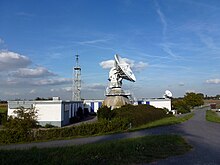Radio measuring point for space radio
The German radio measuring station for space radio, also "radio control measuring station for space radio" or "space radio monitoring system" , or satellite measuring station or radio measuring station for short , is located near Leeheim am Rhein . It is operated by the Federal Network Agency . It is used to recognize and track satellites, whereby frequency , polarization and transmission power can be measured and the orbit can be recorded.
history
The European Conference of Postal and Telecommunications Administrations (CEPT) had previously decided that the tasks of space surveillance should be delegated to the national radio control measuring services. The Deutsche Bundespost then began planning such a control point. The first European "radio control measuring point for space services" was built about 20 kilometers from Darmstadt, the seat of the Central Telecommunications Office (FTZ) , near Leeheim and was handed over to its destination on October 28, 1980.
After the postal reform in 1995, the facility was transferred to the Federal Office for Post and Telecommunications (BAPT). The system is looked after by the branch office of the Federal Network Agency (BNetzA) Eschborn (organizational) and the location of the Mainz headquarters (Info).
Other names of the measuring point were:
- Antenna measurement site for research and test purposes
- Radio control measuring station for space radio in Leeheim
technology
The system can be used to monitor satellites in the frequency range from 130 MHz to 13 GHz. In its first expansion stage it mainly comprised those for weather observation , earth surveying , research and the like. Similar frequency ranges.
In the early 1980s, the measuring point consisted of two antenna systems and a common central building. The frequency band to be monitored is divided into two frequency ranges; both antennas are optimized for one frequency range and can be operated independently of one another. A Cassegrain antenna with subreflector is used for the upper frequency range from 1.3 GHz to 13 GHz . Its main reflector with a diameter of 12 m can be swiveled up to 90 ° in elevation and by ± 270 ° in azimuth .
The antenna for the lower frequency range from 130 MHz to 1.3 GHz is a group of four logarithmic-periodic antennas , which are arranged in a square due to their own tracking according to the monopulse method . Each of these approximately 3 m long individual antennas consists in turn of two orthogonally arranged individual antennas, so that signals of any polarization plane can be received. The azimuth rotation range is unlimited thanks to a rotary coupling for the high frequency and the control signals. The antenna can be swiveled by ± 90 ° in elevation.
The system technology comes from: Krupp , Siemens and Telefunken , among others .
The radio measuring station searches for jamming and pirate transmitters that broadcast illegally via satellites or interfere with satellite signals. Interference processing detects sources of interference that would otherwise hinder the operation of satellite and terrestrial radio services.
literature
-
Instruction sheets of the Deutsche Bundespost
- Ulrich Scherner: radio control measuring service for space ; 35th year; Issue 4/1982; Pp. 213-214
- Edmund Stirner: Antennas ; 36th year; Issue 8/1983; Pp. 307–338 (p. 333)
- News ; 55th year; Issue 2/2002; P. 99
- telcom report, issue 1, February 1982, pp. 21-26 Mü
- RegTP News; No. 4/2001; Pp. 6-7
Web links
Individual evidence
- ↑ teaching sheets : 34th year; Issue 5 from 1981; P. 214
- ↑ Ulrich Scherner; P. 213
- ↑ Ulrich Scherner; P. 214
- ↑ Measuring point for space radio services Leeheim. Federal Network Agency , archived from the original on February 17, 2013 ; Retrieved April 18, 2012 .
Coordinates: 49 ° 51 ′ 11.4 " N , 8 ° 23 ′ 47.1" E
